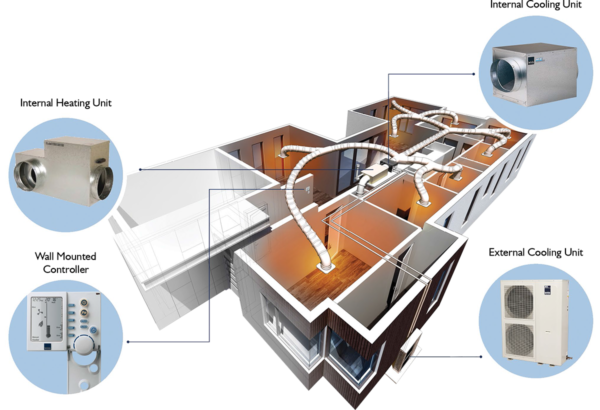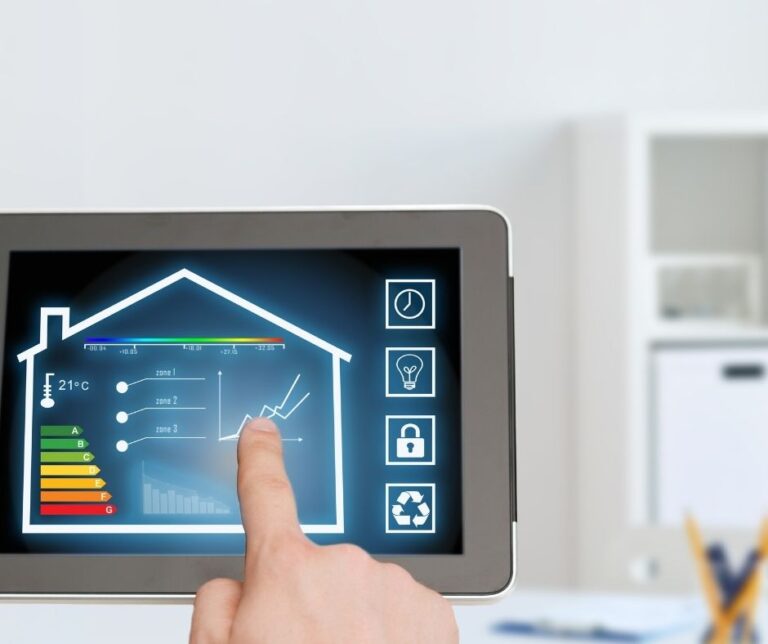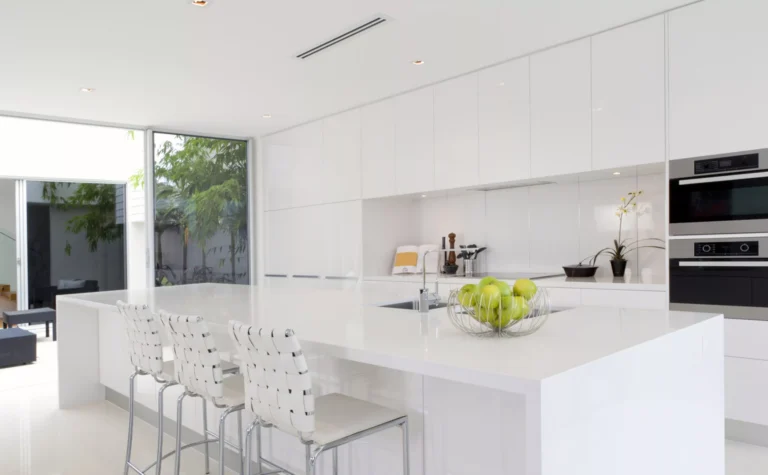Reverse Cycle Ducted vs Split Systems: Comparing Home Heating and Cooling Options
When deciding on an air conditioning system for your home, you might be considering the efficiency and convenience of reverse cycle ducted and split systems.
Reverse cycle ducted air conditioning offers the benefit of whole-house comfort with a single system. This system uses a network of ducts to distribute conditioned air throughout your home.
It not only cools your home during the hot summers but also provides warmth in the winter.
Pros and Cons At A Quick Glance
When you’re considering air conditioning options, it’s essential to weigh up the pros and cons of Reverse Cycle Ducted Systems and Split Systems. Each has distinct advantages and challenges that could significantly impact your comfort and household budget.
Advantages of Reverse Cycle Ducted Systems
- Uniform Temperature Control: Ducted systems are excellent for delivering consistent air temperature throughout your entire home.
- Aesthetics: With only vents visible, ducted systems maintain a clean look, avoiding the need for bulky units on walls.
Disadvantages of Reverse Cycle Ducted Systems
- Initial Costs: Installation can be expensive as it often involves extensive work including ducting throughout your home.
- Energy Costs: If not zoned correctly, they can be less energy-efficient, leading to higher electricity bills.
Advantages of Split Systems
- Cost-Effective: Split systems are generally more affordable to purchase and install than ducted systems.
- Flexibility: You can install individual units in selected rooms, helping you control temperatures in specific areas and reduce energy usage.
Disadvantages of Split Systems
- Aesthetic Impact: Unlike ducted systems, split systems require wall-mounted units that can be visually intrusive.
- Inconsistency: They can result in uneven temperatures across different rooms, as each unit operates independently.

Fundamentals of Heating and Cooling
When considering a heating and cooling system for your home in Australia, it is vital to understand the mechanics behind the two popular types available: reverse cycle ducted systems and split systems.
Principles of Reverse Cycle Ducted Systems
Reverse cycle ducted systems are designed to provide comprehensive climate control for your entire home.
They harness the principles of heat exchange by using a refrigerant to absorb heat from one place and release it in another.
During colder months, they extract heat from the outdoor air to warm the indoors. In contrast, during warmer months, they remove heat from your home to keep it cool.A significant advantage is that the ducts are usually hidden in the ceiling or floor, which maintains the aesthetics of your home.
Principles of Split Systems
Split systems consist of two main components: an outdoor unit and an indoor unit that is typically wall-mounted.They can be used to heat or cool individual rooms or zones in your property.This category of air conditioning operates on a similar heat exchange principle as ducted systems but on a smaller scale.These units are particularly favourable for their ease of installation and lower upfront cost.
System Components
In this section, you’ll find detailed breakdowns of what comprises both reverse cycle ducted systems and split systems, ensuring you understand the key elements of each.
Components of Reverse Cycle Ducted Systems
Reverse cycle ducted systems consist of an outdoor unit, which houses the compressor and condenser, and a series of ducts that disperse air throughout your home.The outdoor unit is typically large and located outside your house. This unit is responsible for exchanging heat with the external environment.
Inside, the ducts are connected to a central fan coil unit that pushes conditioned air through vents located in various rooms.
Zoning technology allows you to control the temperature in different parts of your home independently.
Components of Split Systems
Split systems are simpler in design and include an outdoor unit, which contains the compressor and condenser, and one or more indoor units.
The indoor units are often wall-mounted and consist of an evaporator and a fan. These indoor units handle the cooling or heating of individual rooms.
Control is more direct, with each unit functioning independently, allowing for different temperatures in each space. Split systems are versatile, catering to individual room requirements without the need for extensive ductwork.
Energy Efficiency and Performance
When considering the energy efficiency and performance of air conditioning systems, it’s essential to compare the specific energy ratings and understand the efficiency potential they hold for your home.
Energy Ratings of Reverse Cycle Ducted Systems
Reverse cycle ducted systems distribute air through concealed ducts and are designed to operate for entire homes or large sections of homes.They tend to have an energy rating that accounts for the efficiency of heat production per unit of electricity consumed.
Generally, the more stars on the energy rating label, the more energy-efficient the unit is, which translates to lower energy bills for you.
Energy Ratings of Split Systems
Split systems consist of two units: an indoor unit and an outdoor compressor. These systems usually service a single room or a defined space.
The energy efficiency of split systems can vary greatly, with some models offering high-energy star ratings, resulting in significant savings on your energy bills.
Split systems are assessed on their energy performance in both heating and cooling modes, and these ratings are displayed on the product’s energy rating label for you to review before purchasing.
Installation Considerations
Before deciding on an air conditioning system, you need to understand the different installation requirements for ducted and split systems. Each has its unique process and considerations that will affect your choice.
Installation Requirements for Ducted Systems
Ducted systems require a more extensive setup process due to their complexity.
Your home needs adequate space above the ceiling or beneath the floor to accommodate the ductwork.
It’s essential to have a detailed assessment done by a professional to ensure your home’s structure can support ducted air conditioning.
They will check for sufficient space, assess the load-bearing capacity of walls or roofs, and determine the layout of the ducts to ensure efficient airflow.
Keep in mind that ductwork installation can be quite invasive, necessitating ceiling or floor access and potentially lengthy installation times.
Installation Requirements for Split Systems
In contrast, split systems are less invasive to install and generally quicker to set up.You will need a suitable location on both the interior and exterior walls of your home.
The outdoor unit requires ample space around it for proper airflow and should be placed away from direct sunlight if possible.
On the inside, the wall-mounted unit should be installed high on the wall to ensure optimal air distribution.
Installation often includes running a conduit through a small hole in the wall to connect the indoor and outdoor units. It’s also less disruptive, as most installations can be completed within a day.

Cost Analysis
When considering air conditioning options for your home, it’s important to understand the financial implications of each system. Here’s an insightful breakdown comparing the upfront and ongoing costs associated with Reverse Cycle Ducted and Split System air conditioners.
Upfront Costs Comparison
Reverse Cycle Ducted Systems generally have a higher price tag for initial purchase and installation.
Expect to invest from approximately $5,000 to over $20,000, depending on the size of your home and complexity of the job. The extensive ductwork and larger unit size contribute to this cost.
On the other hand, Split System air conditioners are more affordable upfront.
You can purchase a unit for around $600 to $2,800, and installation costs typically range between $600 and $800 per unit.
As these systems require less complex installation, typically only needing to be mounted and connected to an external compressor, they are less expensive to install. Learn more about the initial costs of split systems.
Running Costs Over Time
The running costs for Reverse Cycle Ducted air conditioning systems can be more economical over time, especially if your system includes zoning capabilities which allow for selective heating and cooling of areas in use.
However, these systems tend to consume more power due to their larger output, which could increase your electricity bill if used frequently across a large area without zoning.
For Split Systems, if you are cooling multiple rooms with separate units, the costs can add up.
While individual split systems are efficient for single rooms or smaller spaces, running several units can lead to substantial electricity costs. Comprehensive comparison of ducted and split systems running costs.
Climate Suitability
Choosing the right air conditioning system is crucial to ensure comfort throughout the seasons in Australia. You’ll need to consider how different systems perform in varied climates.
Reverse Cycle Ducted and Varied Climates
Reverse cycle ducted air conditioning is ideal for regions with extreme temperature fluctuations.
These systems can heat and cool your home efficiently.
A reverse cycle system offers both warmth in the brisk winter and cool relief in the sweltering summer months. The system’s ability to adapt makes it a versatile choice for your all-year-round needs.
Split Systems and Varied Climates
Split systems, on the other hand, are suitable if you require targeted heating or cooling in specific areas of your home. They are particularly effective in places with moderate climates where extreme temperature changes are less common.
A significant advantage of split systems is their cost effectiveness in both purchase and installation, as explained on Australian Climate Systems Blog.
These systems allow you to control the environment of each room independently without investing in additional zoning technology.
Space and Aesthetics
When deciding between reverse cycle ducted and split system air conditioners, it’s important to consider how they’ll fit into your home’s space and the aesthetic appeal they offer.
Space Considerations for Ducted Systems
With ducted systems, your entire home can be climate controlled through a network of ducts hidden within the ceiling.
This is essential for maintaining consistent temperatures across large or multiple-story homes.
The key advantage is the lack of visible indoor units, thus preserving the space and design of your rooms.
Aesthetic Impact of Split Systems
On the other hand, split systems come with indoor units that are mounted on your walls. While these can be more prominent, they offer flexibility in choosing which rooms to cool and their capacity.
You might find them more suitable for individual rooms or smaller spaces, such as apartments or single rooms, where individual units can operate independently.
Maintenance and Repairs
When selecting your air conditioning system, consider the maintenance and repair commitments. Ducted systems require consistent upkeep due to their complexity, while split systems offer a more straightforward approach to maintenance and servicing.
Maintenance Requirements for Ducted Systems
Ducted air conditioning systems involve a network of ducts and vents that require regular cleaning to ensure optimal airflow and to prevent contaminants from circulating through your home.
You must have your ducted system checked annually by a professional.
The professional can inspect and clean the internal components, such as the fans and filters, which are crucial for maintaining air quality and efficiency.
Neglecting this maintenance can lead to reduced performance and higher energy consumption. Learn how a ducted system may need more maintenance over time.
Repair and Servicing for Split Systems
In contrast, split systems have an outdoor unit and an indoor unit, typically wall-mounted, with less intricate internal architecture, thus requiring less frequent servicing.
However, should a part fail, you often need to replace the whole unit, which can be a costly affair.
Simple procedures like cleaning the filters can generally be done by yourself, but for electrical issues or refrigerant recharges, you will need to enlist the services of a trained technician. Discover the nuances between repair and servicing for split systems.
Final Considerations
When assessing the suitability of Reverse Cycle Ducted and Split System air conditioners for your home, it’s crucial to consider their long-term value, the user experience they offer, and their environmental impact. Each of these factors plays a significant role in determining the right choice for your specific needs.
When you are dealing with Beyond Heating and Cooling, we will work out the best solution for your home as we install both options.
Get in touch no for a no obligation quote







